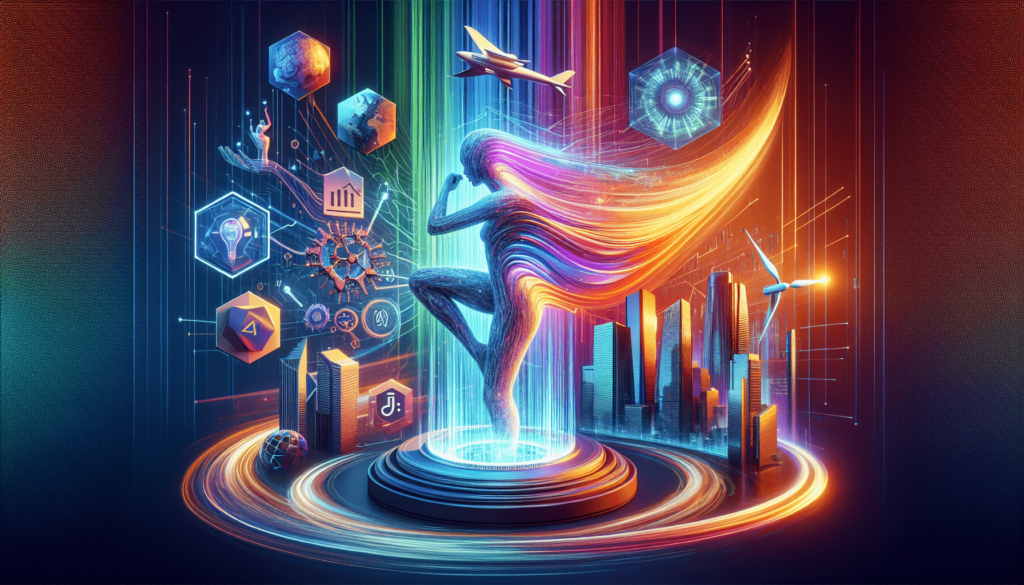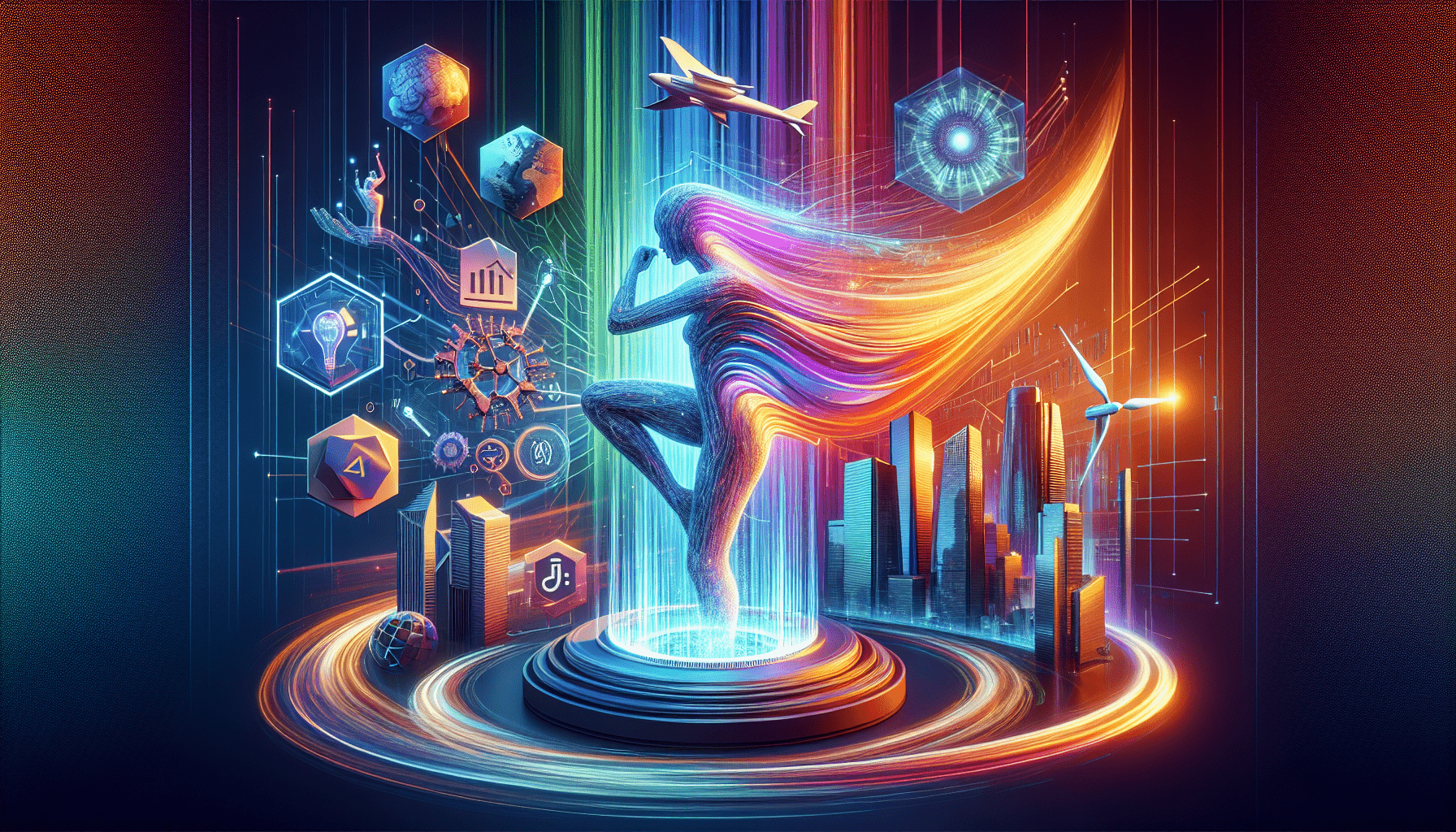Imagine a world where industries are transformed by the power of artificial intelligence. In this exciting era of technological advancements, AI-powered assistants are emerging as game-changers, revolutionizing the way we work and live. From healthcare to finance, manufacturing to transportation, AI is making its mark, enhancing efficiency, driving innovation, and reshaping the future of industries. Join us on this exhilarating journey as we explore the limitless potential of AI and how it is reshaping various sectors, all with a friendly and engaging approach that will leave you eager to learn more.
Introduction
What is AI transformation?
AI transformation refers to the integration and adoption of Artificial Intelligence (AI) technologies in various industries to streamline processes, improve efficiency, and drive innovation. It involves leveraging the power of machine learning, data analytics, and automation to revolutionize existing systems and workflows.
Importance of AI in revolutionizing industries
AI has emerged as a game-changer in today’s rapidly evolving digital landscape. By harnessing advanced algorithms and computational power, AI has the potential to transform industries across sectors. It enables organizations to make data-driven decisions, automate tedious tasks, enhance customer experiences, and gain a competitive edge in an increasingly AI-driven world.
Understanding the Role of AI
Defining AI
Artificial Intelligence, or AI, refers to the ability of machines or computer systems to mimic human intelligence. This includes tasks such as learning, reasoning, problem-solving, speech recognition, and visual perception. AI encompasses a wide range of subfields, including machine learning, natural language processing, computer vision, and robotics.
AI vs. Machine Learning
While AI is a broader concept, machine learning (ML) is a subset of AI. ML involves training computer systems to learn from data and improve their performance without being explicitly programmed. In other words, ML algorithms enable machines to learn from experience and make predictions or decisions based on patterns and trends in data.
AI vs. Human Intelligence
It’s important to note that AI aims to augment human intelligence rather than replace it. While AI algorithms can outperform humans in specific tasks, such as image recognition or complex calculations, human intelligence remains superior in terms of creativity, emotional intelligence, and abstract reasoning. The goal of AI is to work in tandem with human intelligence, empowering individuals and organizations to achieve greater heights.
AI Applications in Various Industries
Healthcare
Within the healthcare industry, AI has the potential to revolutionize patient care, diagnostics, and drug discovery. AI-powered systems can analyze large volumes of medical data to identify patterns or anomalies, leading to early detection and personalized treatment options. Furthermore, AI can assist in surgical procedures, electronic health record management, and telemedicine for remote patient monitoring.
Finance
In the finance sector, AI is transforming processes such as risk assessment, fraud detection, and algorithmic trading. AI algorithms can analyze vast amounts of financial data and identify patterns that humans might miss. This enables more accurate risk predictions, faster fraud detection, and optimized investment strategies. Additionally, AI-powered chatbots are enhancing customer interactions and providing personalized financial advice.
Manufacturing
AI is reshaping manufacturing industries through automation, predictive maintenance, and quality control. Intelligent robots and collaborative robots (cobots) are taking over repetitive and hazardous tasks, improving worker safety and efficiency. AI algorithms can analyze sensor data in real-time, predicting equipment failures and optimizing maintenance schedules. Furthermore, AI-powered computer vision systems ensure product quality by identifying defects or inconsistencies in manufacturing processes.
Retail
In the retail sector, AI is transforming customer experiences, demand forecasting, and supply chain management. AI-powered chatbots and virtual assistants are enhancing customer interactions, providing personalized recommendations, and enabling seamless online shopping experiences. AI algorithms can analyze consumer data and predict buying patterns, enabling retailers to optimize inventory, pricing, and promotional strategies.
Transportation
The transportation industry is being revolutionized by AI through autonomous vehicles, traffic optimization, and predictive maintenance. Self-driving cars and trucks are becoming a reality, promising improved road safety and efficient transportation. AI algorithms can analyze historical traffic data to optimize routes, reducing congestion and travel time. Additionally, AI-powered predictive maintenance systems help detect potential issues in vehicles or infrastructure, minimizing unplanned downtime.
Education
AI is transforming the education sector by personalizing learning experiences, automating administrative tasks, and improving accessibility. AI-powered adaptive learning platforms can analyze student performance data and provide personalized recommendations or interventions. Virtual tutors and chatbots enhance student engagement and provide instant feedback. Furthermore, AI-powered systems can automate administrative tasks such as grading, scheduling, and student admissions, freeing up educators’ time for more valuable activities.

Benefits of AI in Industries
Increased efficiency and productivity
One of the key advantages of AI in industries is the ability to automate repetitive and time-consuming tasks. AI-powered systems can process large volumes of data and perform complex calculations much faster than humans. This leads to increased efficiency, reduced processing times, and improved overall productivity. By automating routine tasks, organizations can focus on higher-value activities that require human creativity and problem-solving skills.
Cost savings
AI implementation can lead to significant cost savings for industries. By automating processes and reducing manual labor, organizations can streamline operations and cut down on labor costs. Additionally, AI-powered systems can optimize resource allocation, inventory management, and supply chain logistics, minimizing wastage and reducing operational expenses. Furthermore, AI can enhance predictive maintenance, reducing equipment downtime and costly repairs.
Improved customer experience
AI has the potential to revolutionize customer experiences across industries. AI-powered chatbots and virtual assistants provide round-the-clock customer support, answering queries and resolving issues in real-time. Personalized recommendations based on AI algorithms enhance customer satisfaction and drive sales. Furthermore, AI-powered systems can analyze customer feedback and sentiment analysis, helping organizations tailor their products, services, and marketing strategies to meet customer expectations.
Enhanced decision-making
By leveraging AI-powered analytics and data-driven insights, industries can make more informed and accurate decisions. AI algorithms can analyze vast amounts of data, identify trends, and predict future outcomes. This enables organizations to optimize pricing strategies, identify new market opportunities, and mitigate risks. Furthermore, AI-powered predictive analytics can assist in strategic planning, resource allocation, and performance forecasting, empowering organizations to stay ahead of the competition.
Challenges in Implementing AI
Data privacy and security
With the increasing reliance on AI technologies, ensuring the privacy and security of data becomes a major concern. The collection and analysis of large volumes of data raise ethical questions regarding data ownership, consent, and potential misuse. Organizations need to implement robust data protection measures, including encryption, access controls, and anonymization techniques, to safeguard sensitive information and maintain consumer trust.
Ethical considerations
AI implementation raises ethical considerations and the potential for biased or discriminatory outcomes. AI algorithms learn from historical data, which may contain systemic biases. This can result in biased decision-making, such as discriminatory hiring practices or biased loan approvals. Organizations must ensure fairness, transparency, and accountability in AI systems and actively work towards eliminating biases and promoting diversity.
Workforce displacement
The adoption of AI technologies in industries may lead to workforce displacement and job transformation. Automation can replace certain tasks or roles, requiring workers to upskill or transition to new roles that leverage their human capabilities. Industries need to anticipate these changes and proactively invest in retraining programs and skill development initiatives. This will enable a smooth transition for employees and ensure a future-ready workforce.
Case Studies: AI Success Stories
Amazon’s recommendation system
Amazon’s recommendation system is powered by AI algorithms that analyze user behavior, purchasing history, and product attributes to provide personalized recommendations. This has significantly enhanced the customer experience, driving sales and customer loyalty. By leveraging AI, Amazon has been able to offer a highly personalized shopping experience, leading to increased customer satisfaction and revenue growth.
Google’s self-driving cars
Google’s self-driving cars, developed under the Waymo project, demonstrate the potential of AI in transforming the transportation industry. These autonomous vehicles use AI algorithms, including computer vision and machine learning, to navigate and make real-time decisions on the road. The technology holds the promise of safer roads, reduced congestion, and increased mobility for individuals who are unable to drive.
IBM’s Watson in healthcare
IBM’s Watson is an AI platform that has made significant strides in the healthcare industry. By analyzing vast amounts of medical literature, patient records, and clinical guidelines, Watson can assist healthcare professionals in diagnosing diseases, identifying treatment options, and predicting patient outcomes. Watson’s cognitive capabilities have the potential to revolutionize personalized medicine and improve patient care outcomes.
AI Transformation Roadmap
Identifying AI opportunities
Organizations need to assess their existing processes and identify areas where AI technologies can be applied to drive efficiency and innovation. This involves understanding the unique challenges and opportunities within the industry and exploring potential use cases for AI. Collaboration with AI experts and industry leaders can help in identifying AI opportunities that align with organizational goals and objectives.
Building the right infrastructure
To leverage AI effectively, organizations need to invest in robust infrastructure, including high-performance computing capabilities and scalable cloud platforms. This infrastructure will support the processing and storage requirements of AI algorithms and enable real-time data analysis. Additionally, organizations need to ensure data accessibility, integrity, and interoperability to enable seamless integration of AI systems with existing IT infrastructure.
Data collection and analysis
Data plays a crucial role in AI implementation. Organizations need to collect and curate high-quality data that is representative of the industry and the desired AI outcomes. This involves data cleaning, preprocessing, and augmentation to ensure data accuracy and quality. AI algorithms can then analyze this data to identify patterns, trends, and insights that can drive informed decision-making.
Integration with existing systems
Successful AI transformation involves integrating AI systems with existing processes, workflows, and systems. This ensures seamless collaboration between AI algorithms and human intelligence. Integration may require modifications to existing systems or the development of APIs to enable interoperability. Additionally, organizations need to provide training and support to employees to ensure a smooth transition and adoption of AI technologies.
Governance and Regulations
Legal and ethical frameworks
As AI technologies continue to evolve, legal and ethical frameworks need to be established to govern their use. This involves defining guidelines and standards for data privacy, algorithmic transparency, and accountability. Additionally, regulations may be needed to address AI-related risks, such as biases, discrimination, and algorithmic decision-making. Collaboration between policymakers, industry experts, and AI researchers is essential in developing comprehensive governance frameworks.
Transparency and accountability
Organizations implementing AI systems must ensure transparency and accountability in their operations. This includes providing clear explanations and justifications for AI decisions and actions. AI algorithms should be auditable, enabling external scrutiny to ensure fairness and ethical use. Transparent AI systems promote trust among stakeholders and facilitate regulatory compliance.
AI governance models
AI governance models aim to ensure responsible and ethical AI deployment. These models involve defining roles and responsibilities, establishing mechanisms for oversight, and promoting ethical decision-making processes. Governance models may involve a combination of industry self-regulation, third-party audits, and government oversight. Collaborative efforts between industry professionals, academics, policymakers, and civil society are crucial in shaping effective AI governance frameworks.
Future Trends in AI Transformation
Advancements in natural language processing
Natural language processing (NLP) is an area of AI that focuses on machine understanding and generation of human language. Advancements in NLP are enabling more sophisticated conversational agents, chatbots, and virtual assistants that can understand and respond to natural language inputs in a more human-like manner. This opens up new possibilities for customer service, content generation, and personalized user experiences.
Robotics and automation
AI-powered robotics and automation are set to disrupt industries by enabling more efficient and flexible manufacturing processes. Intelligent robots and cobots can collaborate with humans, enhancing productivity and safety in work environments. Furthermore, robots equipped with AI capabilities can adapt to changing situations and learn from experience, enabling more complex tasks and applications in areas such as healthcare, agriculture, and construction.
AI in the Internet of Things (IoT)
As the Internet of Things (IoT) continues to expand, AI is becoming integral in unlocking the value of connected devices and sensors. AI algorithms can analyze real-time data from IoT devices, enabling predictive maintenance, anomaly detection, and optimization of resource utilization. AI-powered IoT systems have the potential to revolutionize industries such as smart cities, energy management, and transportation.
Conclusion
The AI transformation is reshaping industries and revolutionizing the way we live and work. From healthcare to finance, manufacturing to retail, AI is enabling organizations to unlock new opportunities, improve efficiency, and enhance customer experiences. While challenges such as data privacy, ethical considerations, and workforce displacement need to be addressed, the limitless potential of AI cannot be ignored. Embracing the AI revolution and leveraging its power can catapult industries into a future where innovation knows no bounds.





